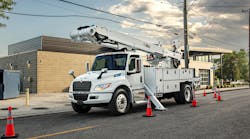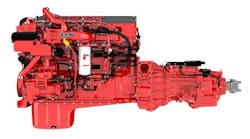A lot of Old School drivers out there remember the first push top bring heavy-duty automatic transmissions into trucking in the 1970s. That attempt didn't go very well.At the time, automatic transmissions with torque converters in passenger cars and trucks were proven and reliable technology. But it turned out that simply "upsizing" a transmission wasn't going to cut it when it came to insuring reliability in tough trucking applications. Super-torquey diesel engines hauling heavy payloads often shredded early automatic truck transmissions. In many cases the internal transmission components simply weren't robust enough for the jobs they were being asked to do. But even when the units were working, it turned out that there was a whole lot more work involved when it came to getting a Class 8 tractor-trailer moving down the road. Given the exponential leap in physics when it comes to trucks -- factors such as mass, velocity and weight -- it quickly became clear that those first generation automatics just couldn't react fast enough, or "smartly" enough, to deal with rapidly-changing road, traffic and geographical conditions.The real breakthrough came with the advent of small, yet powerful, electronic control modules (ECMs) in the late 1990s. Essentially task-specific microcomputers, these pint-sized brain boxes gave vehicle engineers the ability to start programming highly sophisticated performance algorithms into a new generation of automated manual transmissions (AMTs). Suddenly, transmissions were "smart." ECMs constantly monitored vital vehicle data such as speed, horsepower, weight, mass and incline, to make instantaneous adjustments insuring optimal drivetrain performance. And since the base AMT unit was a heavy-duty manual gearbox, component strength and reliability wasn't an issue.Fleets quickly recognized the value of these new transmissions: They are easier to operate and make attracting and retaining new drivers easier. They're simply safer to operate. They are more fuel-efficient and reduce maintenance costs and downtime. Truck manufacturers knew they had a solid product on their hands. But the speed with which AMTs have penetrated the North American Class 7 and 8 truck markets has surprised even their most ardent supporters.For me, the only thing more surprising than their skyrocketing take-rate numbers is how quickly AMTs have evolved and become even more powerful just in the past five years.As revolutionary as the first "smart" AMTs were, today's newest generation of fully integrated drivetrains have taken exponential programming leaps to become powerful, mobile, vehicle management systems.AMTs are truly the "brains" of integrated drivetrains today. In additional to monitoring vital vehicle telemetry, AMTs also "talk" to safety systems like predictive cruise control and consistently work to optimize fuel economy through coast modes and allowing efficient vehicle operation at lower engine RPMs (so called "engine downspeeding").And AMTs are about to get even more powerful. The next generation of smart AMTs (already entering the marketplace) will be GPS-enabled. In addition to all the other data currently being collected and analyzed, these AMTs will add real-time GPS tracking and topographical data to the mix. Called "predictive cruise control," these systems allow AMTs to make throttle and braking adjustments that not only insure the highest-possible fuel economy in current highway conditions, but will also be able to "look" at terrain information beyond a driver's line of sight and set the truck up power-wise to better deal with that terrain.Behind the wheel, I've found the systems to work intuitively and well. Good drivers know to add throttle in anticipation of a hill upheld, or either downshift or let the engine idle during a grade descent to maintain a safe highway speed without excessive braking. Predictive cruise control systems do all these tasks, performing as naturally as a skilled human driver does. The result is reduced stress for a driver due to a significantly reduced workload, increased safety, decreased maintenance and -- again -- consistently high fuel economy numbers.To be sure, AMTs in general, and predictive cruise control-enabled AMTs in particular, offer a high degree of automation that many older drivers find discomforting. On the other hand, in contrast with the poor showing truck automatics gave in the 1970s, today's AMTs have enjoyed a remarkably trouble-free launch and integration into the industry at large. Confidence in the new technology among fleet owners, managers and drivers is consistently high and shows no signs of abating. We hear a lot of talk today about a coming generation of intelligent vehicles. Thanks to the remarkable technology that enabled today's automated manual transmissions, "smart" trucks are already here. And they're not going away.
Voice your opinion!
Voice your opinion!
To join the conversation, and become an exclusive member of FleetOwner, create an account today!
Latest from Powertrain
Latest from Powertrain


